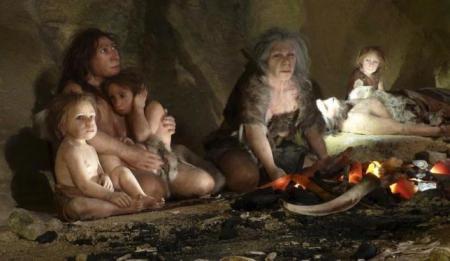Neanderthals Were Human Too

If someone called you a Neanderthal, you wouldn't take it as a compliment. But according to the latest paleoanthropology, it's not that bad.
In one of my favorite commercial series, Geico features a Neanderthal living in the modern world, constantly getting offended at the way people talk about cavemen like they're stupid. This Pleistocene holdover, you see, is sophisticated, sensitive, more likely to visit a club than to hit you with one.
It's no wonder he had a hard time in the modern world. From the moment their remains were first discovered in Europe and the Middle East over a century-and-a-half ago, Neanderthals have been portrayed as primitive, apelike brutes, dragging their clubs around, and grunting nonsense. Writing at The New York Times several years ago, David Frayer tracked the treatment of these extinct people back to the mid-1800s, when Neanderthals were labeled "freaks" and "idiots," "incapable of moral or religious conception." In fact, the scientific name originally proposed for Neanderthals was Homo stupidus!
But fresh evidence now is rehabilitating Europe's earliest inhabitants and their kin. Last year the New York Times ran a story entitled "Neanderthals Were People, Too," detailing new research that would make Geico's caveman proud.
Turns out Neanderthals were artists who mixed their paints in a subtle rainbow of shades. They produced symbolic images and adorned themselves with feathers and eagle-talon pendants. They could sail surprising distances, they traded, used herbal medicines, and even buried their dead with supplies for the afterlife.
And despite decades of consensus that Neanderthals were incapable of speech, Australian scientists announced in 2013 that fossilized Neanderthal hyoid bones, which anchor the tongue, were indistinguishable from our own.
And now, a new genetic theory is challenging the long-held idea that modern humans, with our superior brain power, drove Neanderthals to extinction. Apparently, many of our ancestors got along quite well with Neanderthals. DNA sequencing suggests that most people alive today are part Neanderthal—an average of 2 percent, and as high as 6 percent in some regions. In fact, an estimated 80 gene sequences around today come directly from Neanderthals.
The mixing of ancient human groups, it seems, was far from rare. A paper published last month in Nature describes how a toe bone from a Siberian cave represents the first confirmed cross between so-called "species" of human. Genome analysis reveals that an adolescent girl to whom the toe bone belonged had a Neanderthal mother and a father who was a member of the Denisovans—another group of ancient humans who left their mark on our DNA.
According to zoologist Ernst Mayer, if two living things can produce fertile offspring, they're members of the same species. And Neanderthals, "modern humans" and Denisovans all produced such offspring. So we're living proof!
Why then, asks the Times, did science get Neanderthals so wrong for so long? Well, a major part of the answer are the evolutionary assumptions that have long clouded our thinking on the origins of mankind. Scientists have long interpreted extinct groups of humans as primitive and apelike. But it seems increasingly difficult to deny that Neanderthals were human; and if human, then created in the image of God. Geico's cosmopolitan caveman wasn't as much of a stretch as we thought.
The lesson of the Neanderthals is that storytelling too frequently masquerades as settled science, and that worldview assumptions often are passed off as hard data. Science got Neanderthals wrong because too few scientists were interested in getting them right. And remember, it wasn't that long ago that entire groups of humans were portrayed as primitive and apelike because of similar Darwinian assumptions.
Ideas have consequences. Bad ideas have victims.
Resources
Scientists Stunned by a Neanderthal Hybrid Discovered in a Siberian Cave
- Sarah Zhang | The Atlantic | August 22, 2018
Ancient Girl's Parents Were Two Different Human Species
- Maya Wei-Haas | NationalGeographic.com | August 22, 2018
Neanderthal artists made oldest-known cave paintings
- Emma Marris | Nature.com | February 22, 2018
Originally posted at Breakpoint.




















